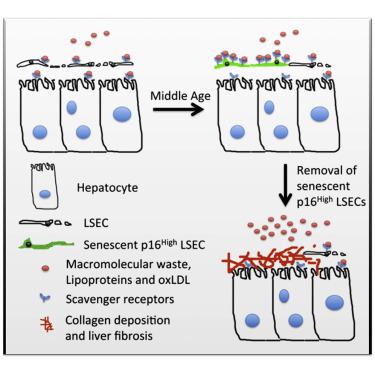Cell Metabolism ( IF 27.7 ) Pub Date : 2020-06-01 , DOI: 10.1016/j.cmet.2020.05.002 Laurent Grosse 1 , Nicole Wagner 2 , Alexander Emelyanov 1 , Clement Molina 1 , Sandra Lacas-Gervais 3 , Kay-Dietrich Wagner 2 , Dmitry V Bulavin 1

|
The accumulation of senescent cells can drive many age-associated phenotypes and pathologies. Consequently, it has been proposed that removing senescent cells might extend lifespan. Here, we generated two knockin mouse models targeting the best-characterized marker of senescence, p16Ink4a. Using a genetic lineage tracing approach, we found that age-induced p16High senescence is a slow process that manifests around 10–12 months of age. The majority of p16High cells were vascular endothelial cells mostly in liver sinusoids (LSECs), and to lesser extent macrophages and adipocytes. In turn, continuous or acute elimination of p16High senescent cells disrupted blood-tissue barriers with subsequent liver and perivascular tissue fibrosis and health deterioration. Our data show that senescent LSECs are not replaced after removal and have important structural and functional roles in the aging organism. In turn, delaying senescence or replacement of senescent LSECs could represent a powerful tool in slowing down aging.
中文翻译:

定义的 p16High 衰老细胞类型对于小鼠 Healthspan 是必不可少的。
衰老细胞的积累可以驱动许多与年龄相关的表型和病理。因此,有人提出去除衰老细胞可能会延长寿命。在这里,我们生成了两个敲入小鼠模型,以最佳表征的衰老标记p16 Ink4a 为目标。使用遗传谱系追踪方法,我们发现年龄诱导的 p16高衰老是一个缓慢的过程,在 10-12 个月左右出现。大多数 p16 High细胞是血管内皮细胞,主要位于肝血窦 (LSEC) 中,在较小程度上是巨噬细胞和脂肪细胞。反过来,持续或急性消除 p16高衰老细胞破坏了血液组织屏障,随后肝脏和血管周围组织纤维化和健康恶化。我们的数据表明,衰老的 LSECs 在去除后不会被替换,并且在衰老生物体中具有重要的结构和功能作用。反过来,延缓衰老或替换衰老的 LSEC 可能是减缓衰老的有力工具。











































 京公网安备 11010802027423号
京公网安备 11010802027423号